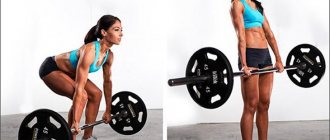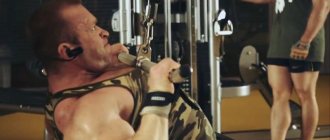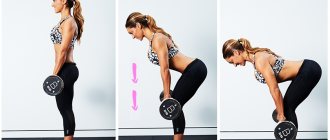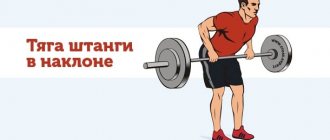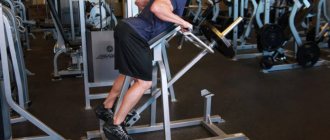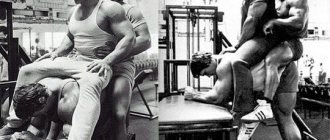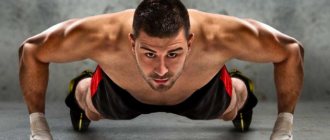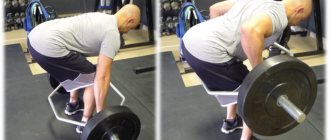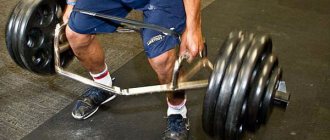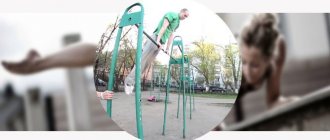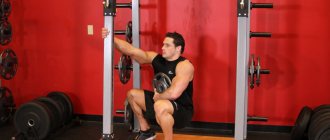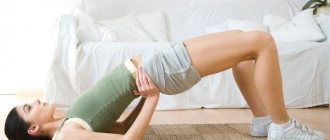The deadlift is one of the key compound exercises that involves a large number of muscles. It simultaneously works the trapezius, lower back muscles, quadriceps and biceps femoris, posterior deltoids and even biceps. Due to the large number of working muscles, the deadlift causes good anabolic response and stimulates the production of your own testosterone. It is this fact that makes the deadlift one of the most effective exercises you can perform in the gym.
Deadlifts place serious stress on the spine and knee joints. For this reason, it is contraindicated for many who have injuries. Deadlifting is also not recommended for beginners, since their muscles are not yet sufficiently prepared for high loads. The solution is to use alternative exercises that work the same muscle groups.
Unfortunately, it is unlikely that it will be possible to fully replace the deadlift ; it engages about a third of the body’s muscles, like almost no other exercise. So before you think about replacing the deadlift, weigh the pros and cons. Well, if more factors speak against it, we have found alternatives that provide a similar load on the same muscle groups that are involved in the work during the deadlift. Pay attention to technique - some exercises can put stress on the knee joints or spine, and if you have any injuries, it is better to avoid them in favor of other alternatives.
Romanian single leg deadlift
Working muscles: gluteal, hip adductors, hamstrings, quadriceps, trapezius, rhomboid, latissimus.
How to replace deadlifts? Romanian deadlift on one leg! The exercise helps to better coordinate the work of the muscles on the right and left sides of the body, which is much more difficult to do during a traditional exercise. Many beginners face this problem: when trying to lift weights, they often use stronger muscles. As a result, the exercise technique changes, the spine begins to experience overload, and the body composition becomes disproportionate. With the Romanian Single Leg Deadlift you won't have this problem.
Another benefit of the exercise is that it helps to work on muscle coordination and balance.
Technique
- Take dumbbells or weights in your hands. Stand up straight and move your left leg slightly behind your body.
- Take a breath. As you exhale, begin to move your left leg back, while simultaneously moving your body forward. When it becomes parallel to the floor, pause and stay in this position for 1-2 seconds.
- Slowly return to the starting position and repeat the same with the other leg.
Details
- During the exercise, your gaze is always directed in front of you, and your back remains straight.
- The exercise can be performed with dumbbells, kettlebells or a barbell.
- As you move your leg back, your heel should point toward the ceiling.
- The supporting foot must be in contact with the floor at all times.
- To develop a sense of balance, practice doing the exercise with a light weight.
How replacing deadlifts will help beginners and athletes after injury
The deadlift (ST) is one of the most serious and effective exercises in bodybuilding. In order to
To perform it effectively and without injury requires special physical training and certain experience. However, not all athletes, even experienced ones, can afford to do it and are looking for something to replace the deadlift that is no less effective, but more gentle on the body. Before we talk about what exercise to replace ST, we note that a full-fledged alternative to this exercise cannot be found, but exercises with a similar load on the muscles can be selected.
Why are they looking for a replacement?
What are the main reasons for looking for an alternative? They are different for every athlete. Some people have a taboo on the exercise due to injury, others have a weak back and are not ready to load the spine. In some cases, an athlete is just starting his journey and is not yet ready to perform ST so well as not to harm himself, and even more so, he is not ready to work with serious weights. Some athletes purposefully avoid it, attributing their dislike of the exercise to anatomical features of the body that interfere with proper execution.
Alternative to deadlifts after injuries
The deadlift is a unique exercise that works two-thirds of the muscle groups. The main load in the process is experienced by the spine; the knees and hip joints are indirectly involved in the process. That is why, if not so long ago there were injuries associated with the spine, hip or knee joints, then it would be correct to replace ST with exercises that will not overload these parts of the body during the period of their recovery. So, for example, to work your back, bending over with a barbell in a standing position or hyperextension is quite suitable.
But you can reduce the load on your knees and hip joints using an exercise similar to a deadlift, but with straight legs. If we are talking about serious injuries that prohibit the performance of exercises with an axial load, you need to choose options that will result in working the trained areas in an isolated manner. If you need to pump up your legs, then bench press, flexion (extension) and extension are suitable. To work out the back, hyperextension will become relevant.
How to replace CT for beginners and athletes with non-standard proportions?
At the initial stage of training, not all athletes manage to master the basics of technique for performing ST, so it is better for them to start with an empty bar, working with it according to the same principle, but without the risk of injury. In addition, you can replace the exercise in this case with an analogue with dumbbells or in a Smith machine, when you can maintain control over the movement of the projectiles. One way or another, initially, beginning athletes need to focus on learning and consolidating the technique and only after that move on to working with serious weights.
What exercise can replace the deadlift for people with an atypical body structure who are not suitable for the exercise for special reasons? If there are no contraindications, then you can replace the classic deadlift with the Romanian one. This exercise is easier to perform and better controlled. True, you won’t be able to do it at home, but in the gym it’s just what you need.
In conclusion, it can be noted that it will not be possible to replace ST with a 100% analogue. You can only select exercises for work in the gym and at home that will help partially fill the gaps created by the inability to perform deadlifts.
Source: biceps.com.ua
Training
Good morning exercise
Muscles worked: gluteals, hamstrings, lats.
Unlike the deadlift, this exercise involves the knees to a lesser extent and is easier for beginners to master. In addition, it works the back of the thigh better due to the increased range of motion. Finally, another advantage of the exercise is that it activates several muscle groups at once, which means it can be called basic. As a result, it causes a good anabolic response and increased testosterone secretion.
Technique
- Take a barbell and “sit” it on the trapezius, as if you were going to do squats with a barbell.
- In the starting position, the body should be straight, shoulders straightened, feet shoulder-width apart, and knees slightly bent.
- Bend forward with the barbell while keeping your back straight. At the same time, move your buttocks back.
- As soon as your body is parallel to the floor, return to the starting position by tensing your gluteal muscles.
Details
- Never look at the floor. The gaze is always directed in front of you.
- Don't chase weight. The working weight in this exercise should be lower than in the classic deadlift.
- Do not round your back, this can lead to spinal injury.
Causes
It is impossible to definitively answer why exactly the lower back hurts. Maybe this is due to a violation of the technique itself, or maybe it is due to overload of the spinal muscles. And sometimes the appearance of unpleasant sensations is a signal of serious violations.
If a beginner has pain after deadlifting, this is quite natural, especially if he previously led a sedentary lifestyle. But it’s a completely different matter if the pain is sharp and acute.
During such squats, the back should be in a natural position, but if it deviates, the spine experiences severe stress.
You can learn the correct technique for squatting with weights only under the supervision of a professional trainer.
You can simply hang on the horizontal bar, or use a warming ointment. All this is only a temporary relief of symptoms, which does not eliminate the causes. It is important to identify the factors that triggered the pain and undergo an examination.
In some cases, the pain factor may be the intensity of the movements performed. Sudden jerks are more likely to cause a lot of trouble than to increase the effectiveness of your training.
A low or high bar is a direct road to back problems. Also, if you pull in your stomach too much during squats, your lower back will round. Taking a deep breath and using an athletic belt will help avoid incorrect execution.
Another reason may be the desire to experiment. Such attempts can be fraught with violation of the integrity of the intervertebral discs. In addition, discomfort may indicate the development of osteochondrosis and complications associated with it.
Also, excessive load can cause protrusion, during which the intervertebral disc moves beyond the spinal column, while the fibrous ring maintains its integrity. Protrusion causes pinching of nerves and blood vessels. A serious complication of the disease, if left untreated, is intervertebral hernia.
Bent-over T-bar row
Working muscles: latissimus, rhomboid, teres major, posterior deltoid.
A good alternative for the deadlift would be the bent-over row, but we decided to replace it with an easier exercise in terms of technique. In addition, the T-bar row uses a parallel grip, which is the strongest. This allows you to work with a higher working weight and activate your back muscles more.
The T-bar row can replace the deadlift only in relation to the back muscles: the leg muscles practically do not work during the exercise.
Technique
- Take the handle of the bar in your hands. So that it ends up between your legs. The arms are barely bent, the bar is suspended.
- Make a slight arch in your lower back; otherwise, your back should remain straight. Bend your knees, but not too much. Look straight ahead.
- As you exhale, pull the bar towards you until it almost touches your abdominals.
- Smoothly lower the bar down and return to the starting position.
Details
- Watch your biceps: they should not take the load from your back.
- Smaller weight plates will not limit the range of motion, so it is better to gain weight from them.
- In the negative phase of the movement, try not to suddenly release the barbell down, but return to the starting position smoothly and without jerking.
Execution technique
Climb
You need to take a deep breath and, as you exhale, quickly but smoothly straighten your legs and body, raising the barbell to your hips. At the end point of the movement, the shoulder blades are brought together and the position is briefly fixed. A jerk should be avoided at the beginning of the movement; the speed of lifting the weight should be the same throughout the entire amplitude.
Lowering
You also need to lower the barbell to the floor smoothly, while maintaining complete control over it. The movement begins with moving the pelvis back. First you need to tilt your body, and after the bar passes your knees, also bend your legs at the knee joints.
Leg bending in the simulator
Working muscles: muscles of the back of the thigh, calf.
This classic hamstring isolation exercise is a great complement to the T-bar row. Together they will create a load on almost the same complex of muscles as in the deadlift. The T-bar row will hit your back muscles, and leg curls will help work the back of your thighs. Only the gluteal and trapezius muscles will remain out of work.
Technique
- Lie on your stomach on the machine, place your legs behind the rollers.
- Take a breath, hold your breath. Raise your legs and exhale during the most difficult part of the exercise.
- Pause briefly at the point of maximum contraction of the hamstrings and slowly inhale to return to the starting position.
Details
- Do not lift your pelvis where the bench bends.
- By changing the position of the feet, you can shift the emphasis - work either the outer part of the muscles of the back of the thigh, or the inner. Heels together - the outer side works more, toes together - the inner side.
- The higher the range of motion, the better. Don't shorten it.
- If you pull your toes toward you during the exercise, your calves will receive additional stress.
Emergency help
If your lower back hurts terribly during training, follow these rules:
- stop the load;
- Lie in a position that minimizes pain. Lie down until the pain goes away. If this does not help, classes should be cancelled;
- You can apply ice or a cold compress to the sore spot and wait for an ambulance. Thermal procedures are not permissible, as they will only aggravate the situation, increasing swelling and inflammation.
Do not self-medicate by prescribing medications to yourself, especially those administered parenterally.
In any matter, a competent approach to business is important. When playing sports, listen to the recommendations of professionals, and if you experience alarming pain, consult a doctor.
Shrugs with dumbbells
Working muscles: trapezius, rhomboid.
Shrugs are a great isolation exercise for the trapezius. And although it is not as basic as the deadlift, shrugs can work this muscle group just as well.
Technique
- Take dumbbells in your hands so that your palms are turned towards your body. Drop your shoulders.
- Breathe. As you exhale, begin to raise your shoulders straight up.
- Pause at the top and slowly lower your shoulders to the starting position.
Details
- Shrugs can be performed with either dumbbells or a barbell.
- During the shrug exercise, the muscles of the arms and shoulders remain motionless.
- Traps love heavy weights, so the working weight in this exercise can be increased.
- In the negative phase of the movement, try not to let your shoulders go down, but return them to their original position smoothly and slowly.
deadlift
Diagnosis and treatment
If an athlete has back pain after deadlifting, it is necessary to consult a doctor and undergo a series of tests. Depending on the general condition of the patient and the nature of the pain, the patient may be prescribed the following procedures:
- MRI (it is especially important for those athletes who suspect a spinal injury to undergo it);
- X-ray;
- general urine and blood tests.
Additional studies may be prescribed to a person based on the results of the initial examination and basic diagnosis. Depending on the diagnosis, a person may be prescribed local treatment (compresses, ointments, pain-relieving injections), general medications that promote tissue restoration, as well as various physical therapy. treatments, including massage.
If there was a serious injury, the patient may be prescribed a temporary restriction of physical activity, and then exercise therapy. He will be able to return to normal sports activities only after complete recovery.
Features of the technique that should be taken into account when replacing
This is one of the basic exercises used in bodybuilding. In order to competently replace it, it is worth considering two main goals pursued by the technique.
The task is to increase strength indicators and form a back frame. It is also important to know that during the execution all muscle masses are involved. Therefore, if the technique is correctly implemented, it causes a significant increase in muscle mass.
At the same time, this is far from the safest method. If this is done without proper training, it can result in injury, and serious injury at that. The consequences of this will interfere with life for a long time.
It is clear that you should not resort to this technique if:
- lower back pain;
- hemorrhoids are present;
- scoliosis is present.
Of course, the question arises of what can replace this with such problems. There are a number of options that will allow, albeit not to the same extent, but still develop the same muscles. In this case, you will not have to resort to the stress that such a technique inevitably causes.
Sumo or classical (classical)?
- What is the difference between these two types of traction? Well, the answer is obvious: the position of the legs. Depending on the width of your legs, the height of the barbell changes. The wider the legs are spread, the lower the lifting height of the projectile. Those. By placing your feet wider, you simply make the task a little easier for yourself and reduce your range of motion.
- Typically, the classic deadlift is chosen by people with shorter legs and a longer torso. Still, the sumo style requires a certain flexibility and mobility in the hip and knee joints.
- With the sumo deadlift, all the hip adductors are more fully involved. The classic technique loads the back a little more.
- Classic requires parallel placement of the feet. Sometimes trainers advise turning them slightly to the sides. When doing sumo deadlifts, your goal is to rotate your feet 45 degrees outward.
Both deadlift variations are equally good. If you are in doubt about the choice, experiment with both options. Only then will you be able to figure out what is more convenient for you to do. The sumo deadlift has its pros and cons, just like the classic one, so the choice between them is a purely individual matter and depends on your personal comfort.
